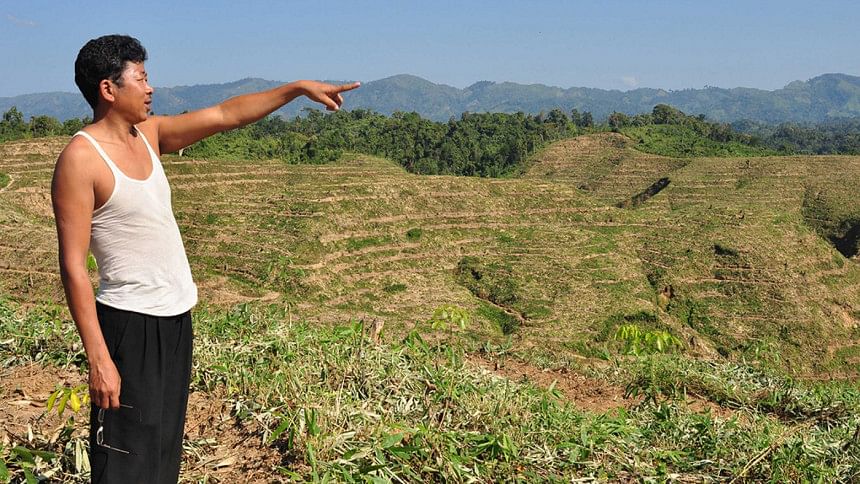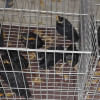Ending deforestation by 2030: An empty promise?

Bangladesh is amazingly green. Yet, historically, our natural forests have always been limited. In 2000, the Bangladesh Bureau of Statistics estimated our total forest area to be 2.6 million hectares. However, according to the Forest Department's "National Forest and Tree Resources Assessment 2005-07" report, the extent of legal forest land is 1.4 million hectares, which is 9.8 percent of the total land area in the country. The UN's Food and Agriculture Organization (FAO) indicates a much worse condition of our forests: In 2009, the actual coverage of forest was merely 6.7 percent. The Forest Department identified 17.62 percent of the country's land area as forest in 2016.
The Bangladesh side of the Sundarbans, the largest mangrove forest in the world, is spread over Khulna, Bagerhat and Satkhira districts, covering 601,700 hectares. The largest area of forestry in the country, the Sundarbans is constantly hit with disasters both natural and man-made. Foremost among the natural disasters are storms and tidal surges. The biggest of the man-made disasters, on the other hand, is extensive tiger prawn (Bagda) farming. According to conservative estimates, more than 200,000 hectares of mangroves have been cut down along the coast line in different places of the forest to facilitate prawn farming.
The Chakaria mangrove forest in Cox's Bazar has completely disappeared due to prawn farming. It is because of the demise of this unique mangrove patch that half of the people of Baddarkhali town on its northern edge lost their lives in the 1991 cyclone—one of the deadliest cyclones on record.
Our second biggest forest after the Sundarbans is located at the Chittagong Hill Tracts (CHT), covering 322,331 hectares. This hill forest used to be home to 11 indigenous groups. Then, to their great dismay, the British crown promulgated Act VII in 1865, and the forest-dwelling people in the CHT and elsewhere in the county were stripped of their customary rights to the forest and land. During British rule, 24 percent of the CHT was declared as reserved forest. Commercial afforestation began in the hills with cultivation of teak, an exotic species to Bangladesh. Later on, the Kaptai hydropower project, road construction, social forestry, Karnaphuli Paper Mills, militarisation, and the settlement of Bangalees contributed greatly to the drastic decline of CHT forest resources.
Monoculture plantations with exotic species, sugar-coated as social forestry, have severely damaged our natural forests. Rubber and tobacco cultivation in Cox's Bazar and Bandarban over the past few decades has proven to be another key factor for deforestation. On top of that, there has been massive hill-cutting and deforestation for construction of the Marine Drive from Cox's Bazar to Teknaf. Many hills have been shaved to make shelters for Rohingya refugees. Due to the deforestation, wild animals have disappeared from the area, and the movement of endangered elephants has been disrupted.
Very little of the sal forest in the north-central and north-western parts of Bangladesh survives today. The Modhupur sal forest used to be a continuous patch of 45,000 acres. Attached to that was another 17,000 acres of the same type of forest in Mymensingh's Muktagachha upazila. Both Modhupur and Muktagachha forests are history today. What were once dense forests have been reduced to rubber monoculture and pineapple, banana and spice orchards. In places, there are social forestry patches primarily grown with acacia.
The major factors behind the massive deforestation and precise ecocide we have seen in Modhupur and elsewhere over the last three decades are wrong strategies and plantation projects funded by our development partners. The plantation projects funded by the World Bank to create a green fence along the coast have been severely affected by prawn cultivation, promoted and funded by donor countries. Recently, the World Bank's USD 175 million project, Sustainable Forest and Livelihoods (SUFAL), has also failed to show any improvement. The huge project, set to be completed next year, has followed the same models of forestry that have proven to be ineffective.
Apart from the sal forests in Modhupur and Muktagachha, there are patches of sal forest at Fulbaria upazila in Mymensingh, Kaliakair in Gazipur, and in Tangail. These patches of nearly 60,000 acres, known as the Attia Forest, are now in the grips of land grabbers. Industrial establishments, roads, human habitation, bazaars, schools, madrasas and many other constructions have spread in and around this forest. The waste from nearby cities are indiscriminately dumped and burned in many places inside the forest. If you go east from Chandra circle in Kaliakair upazila, you will see burnt sal trees on both sides of the newly expanded highway.
The Forest Department is helpless in the Modhupur and Attia sal forest areas. Allegations are widespread that those involved in the deforestation and abuse of the forest areas are primarily political leaders, businessmen and elected public representatives. Rubber monoculture, a big threat to forest ecology, is primarily an activity of the Forest Department. Corruption of dishonest forest employees and officials and their collusion with the forest despoilers are equally widespread.
In recent decades, the so-called social forestry and other plantation projects funded by the Asian Development Bank (ADB) and the World Bank have dramatically changed the forest landscapes. Everywhere in the forest areas, we see huge plots of exotic acacia and few other species, devoid of understorey vegetation of diverse plant species—which is typical of natural forest patches. The practice of social forestry requires harvest of planted trees every 10 years or so, and thus creates perfect conditions for the land grabbers to step in.
A ray of hope was briefly shone at the 26th UN Climate Change Conference (COP26) in Glasgow, Scotland last year, when the world leaders, including our prime minister, pledged to stop deforestation by 2030. The world leaders' declaration came on November 2. However, Bangladesh endorsed it on November 4—an indication that our leaders at COP26 were not well-prepared!
Considering the recent trends of deforestation and their underlying factors, it is indeed hard to believe that deforestation will ever come under control, let alone end by 2030. Yet, we want to be optimistic, but not without concrete actions, particularly from our government. First of all, the government must show that it is determined to formulate appropriate forestry policies and strategic programmes to protect our forests. Thanks to the ADB, it has completely withdrawn from the forestry sector after the colossal damage its investment caused to our natural forest patches. The World Bank also slowed down with the forest projects, but came back with SUFAL, a big forestry project. Evidence abounds how forestry projects funded by these multilateral development banks (MDBs) and donors can cause irreparable damage to our forests and environment. Our failure to be bold in taking right policy decisions will prove that the world leaders, including ours, made empty promises at COP26.
Philip Gain is a researcher and director at the Society for Environment and Human Development (SEHD).

 For all latest news, follow The Daily Star's Google News channel.
For all latest news, follow The Daily Star's Google News channel. 








Comments